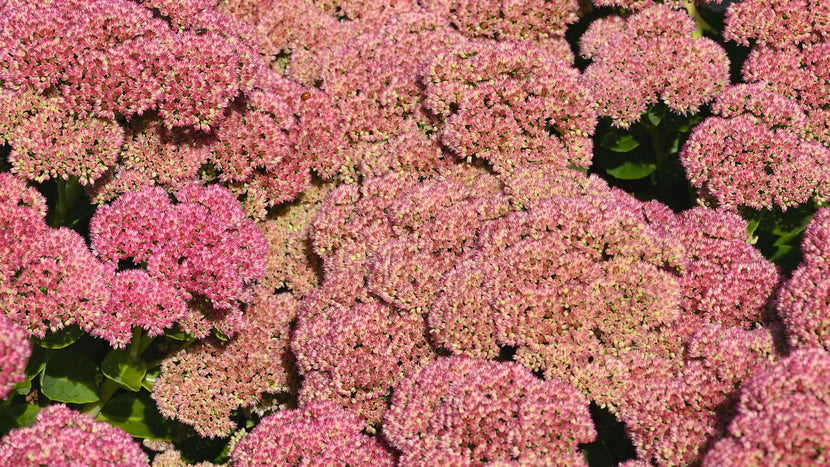How to Plant Sedums in the Garden
Plant Guide

Sedum plants or Stonecrops are succulent plants that have found their way into the American landscape. Perennial sedums come in two distinctly different forms. Upright sedums or upright sedums hold their flowers atop strong upright stems, and creeping sedums trail along the ground or hang down over the edges of containers and can often be seen acting as "spillers" in mixed containers.
Upright sedums do not spread like creeping sedums. The clumps do increase in size year after year, producing more and more flowering stems each spring. The spreading sedums spread through growing roots on the stems when they come into contact with the ground. Creeping sedums are not considered invasive and can often be used as a ground cover in rock gardens or sunny mixed gardens
Choosing the Best Sedum varieties for your Landscape
Upright Sedums: The upright or clumping sedums are best used in the middle layer of a good landscape design. They can reach heights of up to 2 feet when in flower, and the succulent leaves have a pleasing blue-green color which can be used to cool warmer colors like the red coloration of heuchera leaves.
Upright Sedum, like Sedum Autumn Joy Sedum, begins flowering in the late summer, and the flowers remain upright through the winter. This gives the sedum the ability to create winter interest, and the flower heads look great with a covering of snow.
Creeping Sedums: The creeping sedum types can often be seen covering large areas in the garden. They grow well with other perennials and are often seen with other perennial plants growing up through the mats of colorful foliage. Many gardeners also use sedums to soften the edges of raised beds or container plantings.
Trailing sedums, like Sedum fuldaglut, are excellent choices for rock gardens as they will meander over larger stones and outcroppings. Creeping sedums come in a myriad of colors, from red and yellows to soft blues and greens.
Both types of sedums thrive in dry conditions where other plants may not grow. We always say that "Sedums will grow where others will not," making this a plant that thrives on neglect.
Ground Rules
Light
All sedum varieties thrive in full sun. Sedums will tolerate some afternoon shade, be sure that sedums get 4 to 6 hours of full sun. If grown in shaded areas, sedums may not flower as vigorously as those grown in full sun.
Water
Sedums are extremely drought tolerant. They store water in their fleshy leaves, allowing them to survive in periods of extended drought. Sedums are good choices for xeriscape and, once established, will require no additional water. This makes sedums perfect for use in mixed containers that may not receive watering regularly.
Soil
Sedums prefer well-drained soil and will not tolerate standing water or areas that stay wet in the winter. Excess moisture can cause the root ball to rot.
Food
Sedums are not heavy feeders and only benefit from a spring application of fertilizer such as Espoma Flower-tone, for example. Choose a well-balanced fertilizer and try to avoid fertilizer that contains high amounts of nitrogen as this can cause the plants to develop lots of foliage but at the expense of flowering.
Temperature
Sedums are very hardy, and most can tolerate cold weather down to Zone 4.
Toxicity
All members of the sedum family are considered non-toxic to both humans and pets.
Mulch
Sedums do well with a light coating of mulch. We recommend no more than one inch around sedums. Sedums are just as happy with a mulch of gravel as they are with organic mulches. Too much mulch can cause the base of the sedum to rot.
Planting Process
- Unbox the sedum plant and remove the packing. Water the plant and place it in a partially shaded location to acclimate to its new environment for a day or two.
- Select a location for your new plant(s) based on the light and soil requirements of the plant.
- Dig a hole wider than the pot but not deeper. It is essential with sedums not to plant the plant too deep. This can cause water to pool at the base of the plant during each rain.
- Place the sedum in the hole, making sure the base of the plant is above the level of the existing soil. Backfill the rootball being careful not to leave any voids or air pockets. Mulch the plants with a thin layer of mulch or gravel.*Note: It is not necessary to amend the existing soil with compost when planting sedums.
- Water the plants deeply after planting and only after the soil surrounding the plants is dry. Excess watering is detrimental to sedums and will only require weekly watering for the first four weeks after planting. No additional watering will be necessary during the growing season.Follow these steps and sedums will bring you many years of enjoyment in the landscape.
Type of Sedum Available at Garden Goods Direct:
| Name: | Spread: | Flower Color: | Foliage Color: |
|---|---|---|---|
| Sedum Autumn Fire | 2 Feet; Clumping | Rose Pink | Bluish-Green |
| Dragon's Blood Sedum | 2 Feet; Spreading | Hot Pink | Green/red in summer; Dark red in fall |
| Sedum fuldaglut | 12 Inches; Spreading | Reddish-pink | Green-Bronze |
| Sedum Angelina | 1 to 2 Feet; Clumping | N/A | Golden-green, reddens in fall |
| Sedum Autumn Joy | 2 Feet; Clumping | Rose Pink | Grey-green |
